The hybrid workforce model has rapidly emerged as the new standard in the modern workplace. In a recent survey, more than 83% of the respondents stated that the hybrid workplace model was the ideal work environment.
This shift reflects a growing preference for the flexibility and balance that hybrid work offers, combining the benefits of remote work with the collaborative advantages of in-office presence. As businesses continue to adopt hybrid workforce models, it’s crucial to implement best practices that ensure productivity, engagement, and seamless collaboration across a diverse workforce.
In this article, we will explore the hybrid workforce best practices that help organizations thrive in this dynamic work environment.
What is a hybrid workforce?
A hybrid workforce is a working model that combines both remote and in-office employees, allowing flexibility in where and how work is performed. In this arrangement, some employees work from the office, while others work from remote locations, such as their homes or co-working spaces. Additionally, many employees may alternate between remote and in-office work based on their roles, tasks, or personal preferences.
This model aims to leverage the benefits of both remote work and traditional office environments. It provides employees with the flexibility to balance their work and personal lives more effectively while maintaining opportunities for face-to-face collaboration and team-building when necessary. The hybrid workforce model is designed to enhance productivity, improve work-life balance, and meet the diverse needs of the modern workforce.
8 best practices for managing a hybrid workforce
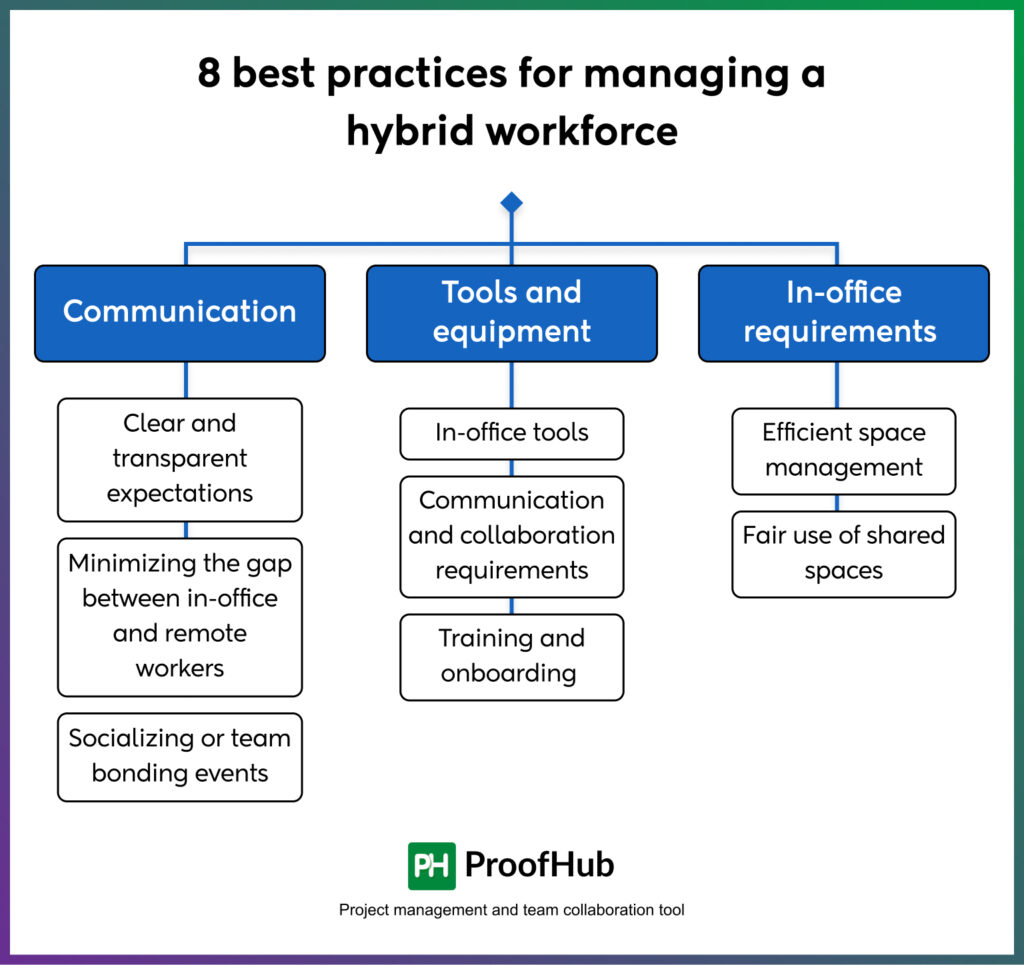
When it comes to implementing hybrid workforce best practices, multiple factors should be considered before framing the best practices.
For this, I have categorized these 8 hybrid workforce best practices into 3 different groups, each highlighting different perspectives. Together, these 8 best practices will be able to help you develop a successful hybrid work culture.
Communication
2-way communication is the key aspect of a hybrid work culture. Establish a clear platform where your employees understand your expectations.
Communication is a wide aspect, so I have come up with 3 hybrid workforce best practices under this category that will further simplify the process of setting up an efficient communication culture.
1. Clear and transparent expectations
When it comes to the hybrid model work culture, it is trust that serves as the cornerstone.
Set clear expectations and provide your team members with the space to be accountable. Do not indulge in micro-management. Instead, be open to feedback and opinions from your team members.
Leaders and other experts who have mastered the art of managing hybrid teams talk about how trust lays the foundation for team members working in a hybrid work arrangement.
For a smooth work environment, establish guidelines in written form. This will eliminate assumptions and allow team members to work with a clear mindset. When it comes to team members working remotely, keep everything in black-and-white, i.e., documented.
This should include reporting hours, face-to-face meetings, working hours, and being a part of other team meetings.
2. Minimizing the gap between in-office and remote workers
As managers, we are tasked with the necessity to ensure that the entire team members are on the same page. However, natural circumstances build a wide gap between remote teams and in-office teams.
Eventually, this leads to a scenario where your team members are not in sync with each other. This leads to improper coordination and delays in project completion. The quality of the projects is also affected.
To overcome such issues, the best method is to build an environment where your team members interact with each other regularly. This is where a hybrid work culture provides you with the platform for in-office working.
Remote team members get the opportunity to interact with peers during the in-office stint. By bringing remote and in-office team members together, you can create a platform for efficient and seamless working.
3. Socializing or team bonding events
Remote team members have this general tendency to feel left out. This is because of the lack of regular interaction with co-workers and face-to-face meetings.
Video calls and conferences do provide a respite to a certain extent but fall short when it comes to conveying emotions. This is where you need an efficient system for staying connected with your employees.
To overcome this jinx, the best method is to organize socializing or team bonding events. This will help break the ice and provide a platform for different employees to interact with each other.
Further, with effective team bonding activities, team members understand the overall workflow and structure of the organization. This comes up as a win-win situation for both the employees as well as the business.
Tools and equipment
When it comes to working remotely, you need to ensure that your team members have equal access to all the resources and other necessary project files.
You need to provide your team members with the necessary tools and equipment for a seamless work progression. I have further broken down this section into 3 sub-headings, each describing their role in building a successful hybrid culture.
4. In-office tools
In order to create a hybrid work culture, you need to build an office with sufficient access to amenities and other requirements. This includes comfortable and aesthetic surroundings, high-performance equipment, and management tools.
Hybrid workspace design incorporates the culture of shared in-office workspaces. This brings up the requirement for real-time updates about the prevalent conditions in the office.
For the seamless functioning of your hybrid office, you would need a tool that assists with functionalities related to desk management, real-time calendar and schedulers for meetings and events, video conferencing equipment, and displays.
It would be effective for businesses to use a minimal number of tools to keep the expenditure low as well as for ease in renewal of subscriptions.
5. Communication and collaboration requirements
Hybrid workspace management may feel redundant and complicated when you do not have the proper tools and equipment to manage your team. Provide team members working from remote locations with suitable equipment.
Your team members working remotely want to hear feedback from HUMANS. Do not just set up a work culture where your team members are reporting to AI tools and getting feedback from the same.
As managers and leaders, we need to make the extra effort to provide direct feedback to employees working remotely from varied locations. This will provide them with valuable motivation and inspiration to work intently.
Do not create an environment where your remote employees are treated differently in comparison to the in-office workers.
For instance, Announcements about changes to work conditions and other general information should be brought to the attention of all your team members at the same time.
Further, project management and team collaboration tools and software for managing your hybrid teams, provide you with a unified platform for managing your tasks and communicating with your team members.
6. Training and onboarding
Hybrid work culture is still relatively new, therefore, you cannot expect employees to be aware of the intricate nuances in the first go. Additionally, as managers and leaders, we should be open to learning new skills whenever faced with challenges.
Remote working provides team members with the comfort and opportunity to work from any place irrespective of their geographical location. You should provide them with the equipment and the tools to set up a work environment in their location.
Providing team members with allowances to set up office space goes a long way in showing your respect to remote workers. They will feel at par with in-office employees and work with dedication and intent.
But with remote working comes the issue of compromise in their personal life. Team members should be able to define clear boundaries to prevent overworking.
Encourage your employees and ensure they are working only as per the schedule. Motivate them to pursue a hobby and do other things to spend their time productively.
In-office requirements
Hybrid work culture not only focuses on remote working. The focus is also on improving the working conditions in the office as well.
After all, when your team members get comfortable working remotely, how will you motivate them to come back to the office? You will have to do something magical.
Jokes apart, the infrastructure and the appearance of the office also play a key role in streamlining the hybrid work culture. This not only means that you make the office look aesthetically appealing but also provide things that will capture the attention and interest of your workers.
7. Efficient space management
There have been revolutionary changes in the way an office is built and conducted. Cubicles and workstations have paved the way for shared working spaces. This simply implies that team members coming to the office can sit anywhere and complete their tasks.
Space utilization plays a key role in hybrid workspaces. You should have the ability to convert your office workplaces into multi-purpose spaces. This will enable your team members to work on their respective tasks with ease.
Further, workplace experience platforms serve as the central hub for managing hybrid workplaces and provide real-time updates and insights related to space usage, attendance, and performance.
This will play a key role in ensuring that you use your office to its maximum potential. Further, as you work from a smaller office, efficient space management provides you with the ability to manage activities with ease.
8. Fair use of shared spaces
When it comes to hybrid work culture, shared spaces play a huge role in providing employees with engagement opportunities. Shared spaces include conference halls, meeting rooms, huddle spaces, and others.
You need to set up guidelines on the usage and accessibility of these shared spaces. Implement a ‘first come, first serve’ rule in places where you expect a rush.
Ensure that these shared spaces are easily accessible and with functional amenities at all times. This will ensure that teams coming to the office will have a productive outcome when they leave the office.
These 8 hybrid workforce best practices can help you with a smooth hybrid work arrangement.
Why hybrid work is gaining popularity?
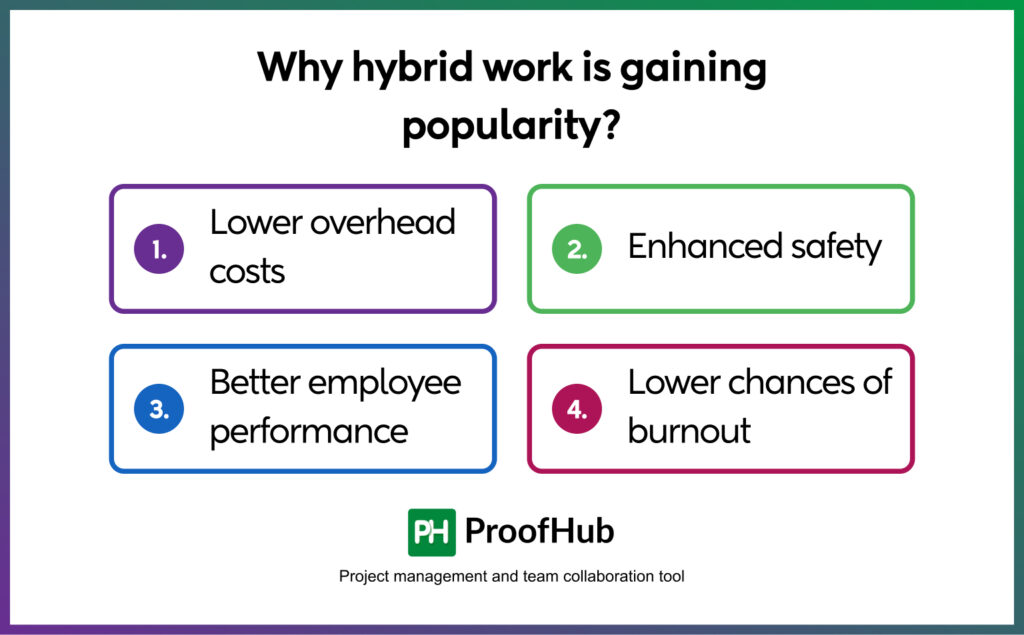
1. Lower overhead costs
Businesses and companies can lower their expenditure on infrastructure and office spaces. This is because businesses can rent out small offices outside the city instead of large offices in the city center.
2. Enhanced safety and workplace etiquette
Hybrid working helps you in providing a safe working environment for your employees. Being away from colleagues makes your employees responsible and follows etiquette for efficiently managing activities.
3. Better employee performance
With a hybrid work culture, your team members get flexibility in their schedules. By integrating work-life balance with well-being, you provide your team members with a platform for completing projects on time.
4. Lower chances of burnout
When your team members are working from home, they are not affected by external factors. This helps you to plan your work schedule as well as the work-life balance for your employees accordingly.
With a timely schedule and flexible work preference, the chances of burnout among your employees are lowered.
Read more: Work from home burnout: 5 red flags and ways to prevent them
What are the major callenges of managing a hybrid workforce?
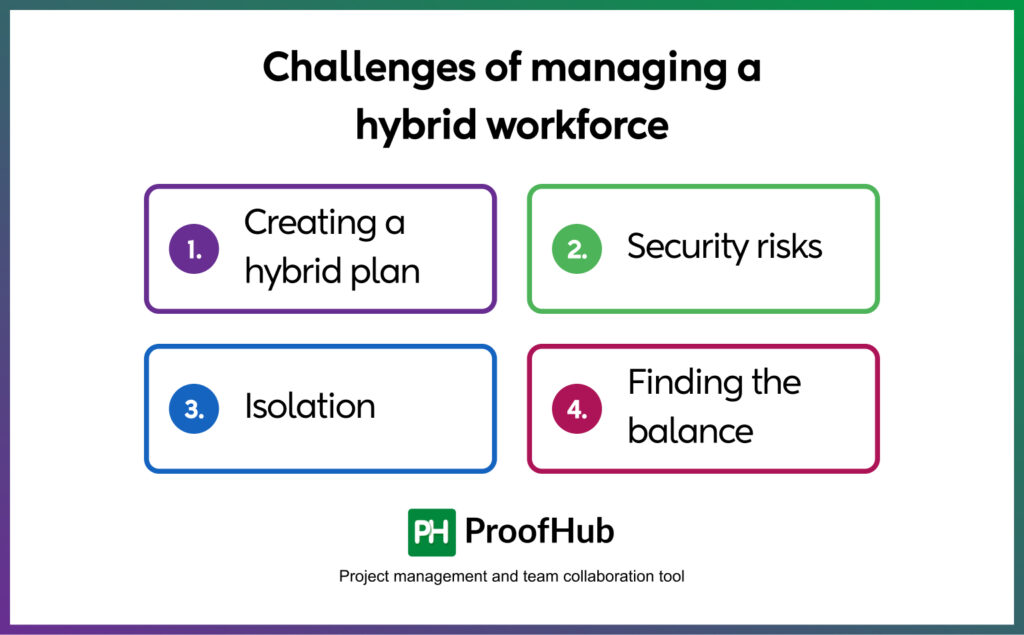
Although a hybrid workplace culture provides businesses with several benefits, there is always a downside that we need to consider at all times, The primary challenges that hinder a hybrid workforce include
1. Building an effective hybrid plan
Simply put, hybrid workforce management is a relatively new concept. Therefore, the chances of building a highly productive team are limited to making smart choices. There are no pre-defined conditions on which you can build this hybrid workforce concept. This makes it difficult for managers and leaders to build efficient and solid strategies for implementing hybrid team management.
2. Security risks
Hybrid workforce management comes with several security issues and may even lead to lapses. This may be due to the availability of confidential files and documents that are now accessible to people outside the business.
3. Isolation
Remote working enhances productivity by letting team members work with enhanced concentration. There is one issue that may cause your team members to feel left out. Employees working from remote locations may start feeling out due to minimal interaction with colleagues. This further hampers productivity and eventually lowers the work completed.
4. Finding the balance
A hybrid workforce is a combination of time, location, and other factors that influence the working conditions of the employees. The ratio between the different factors plays a key role in keeping up with the engagement of your team members.
Read more: Improve hybrid team bonding with these 10 best and easiest remote team-building activities.
Essential tools for implementing hybrid workforce model
When it comes to successfully implementing hybrid workforce best practices, the need for a project management tool comes to the fore.
This is because a tool will minimize the manual process and serve as the centralized dashboard for planning, scheduling, delegating, and monitoring the overall progress of the tasks.
Keeping the above in mind, for a seamless hybrid work culture, ProofHub serves as the best one-stop solution for managing your hybrid team.
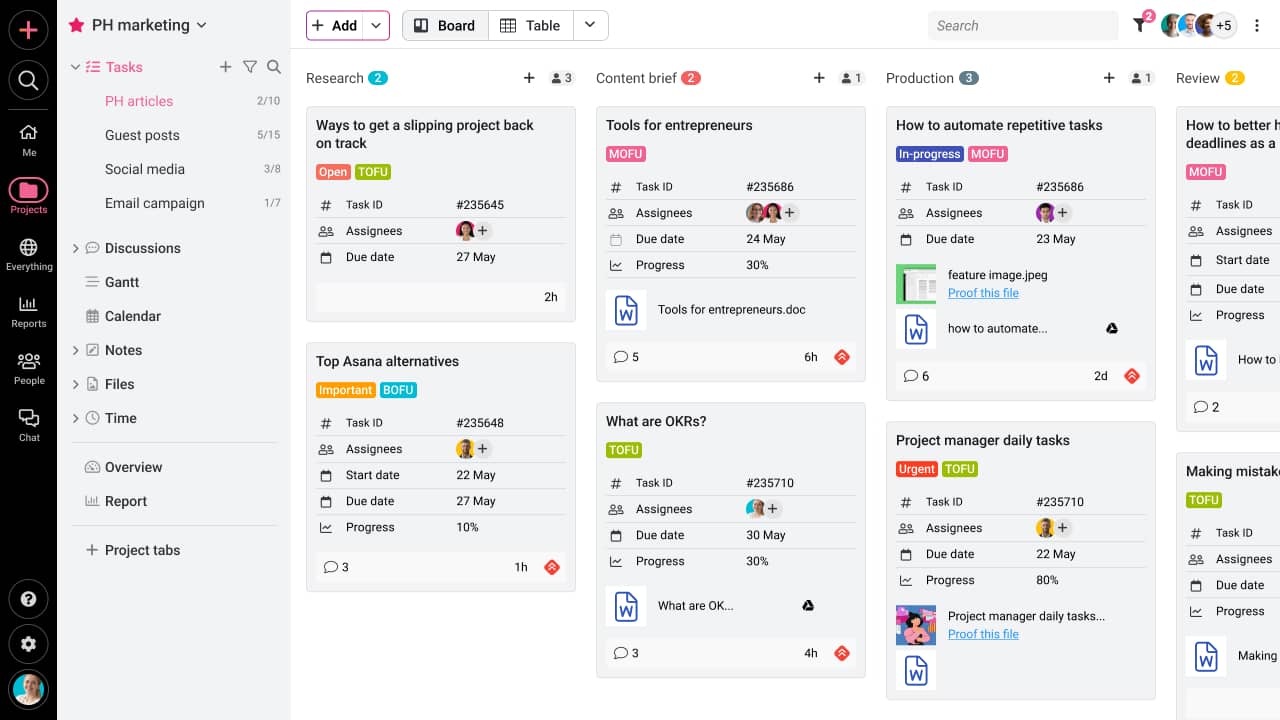
This is because ProofHub not only gives you control over your tasks but also provides you with the functionality of built-in chat and collaboration functionalities that ensure that team members are always on the same page irrespective of their geographical location.
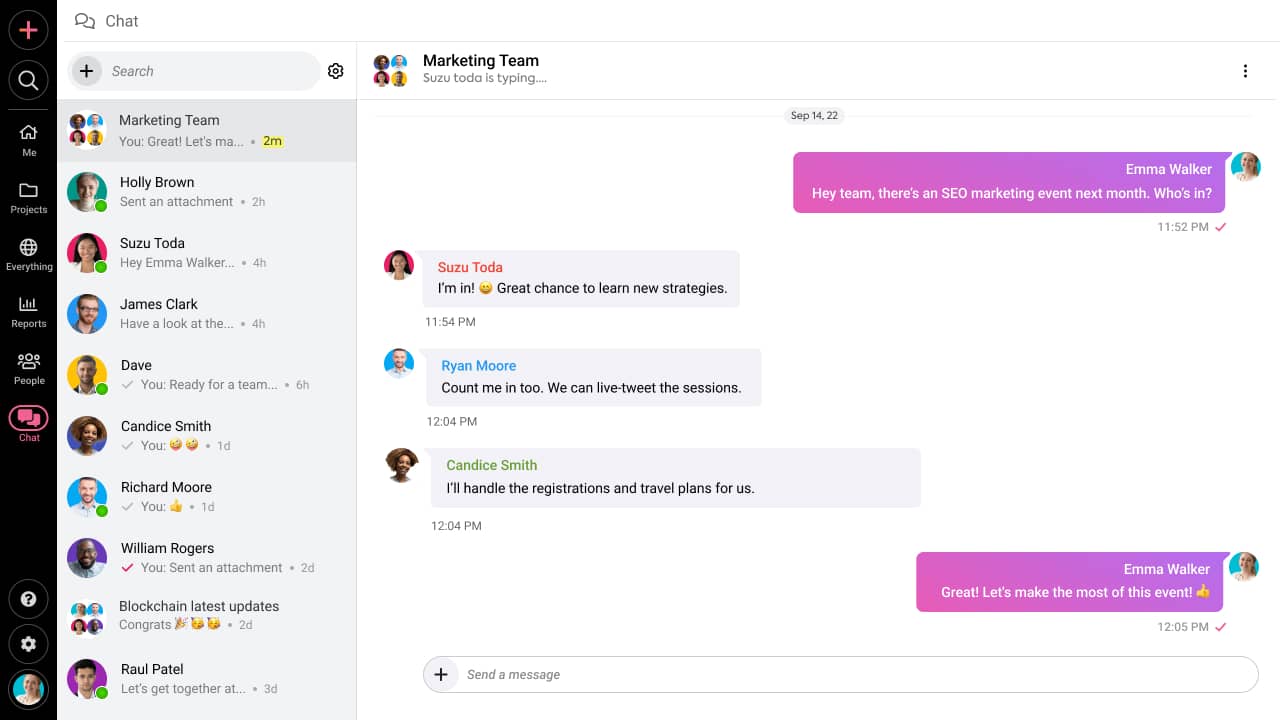
Choosing ProofHub for managing your hybrid workforce should be a no-brainer decision. By serving as the all-in-one tool you can save time spent in switching between multiple apps and completing all project-related conversations and activity on the same dashboard.
Conclusion
Hybrid workforce model is not just a response to current trends but a strategic approach to make the organization future-oriented. By implementing best practices companies can create a harmonious and productive work environment that benefits both employees and the organization.
In order to deal with the complexities of a hybrid workforce, organizations require effective strategies and the right tools. With its comprehensive project management and collaboration features, ProofHub emerges as the ideal solution for managing remote and in-office teams seamlessly.
By integrating ProofHub into your hybrid workplace, you can streamline communication, enhance productivity, and foster collaboration, ensuring that your organization succeeds in modern work.
FAQs:
What are the 4 pillars of hybrid working?
The 4 pillars of hybrid working include flexibility, technology, communication, and well-being.
What are the best tools for building an efficient hybrid workplace?
For building an efficient hybrid workplace, you could use tools like ProofHub, Slack, and other tools that help you in quick communication, efficient collaboration, and managing the overall project progress.
What is the difference between hybrid and flexible working?
Hybrid working is a combination of working from office and remote working. The employees have the flexibility to choose between these two options as per their comfort and requirements.
Flexible working on the other hand refers to adjusting the working hours and the location as per individual requirements.
Why is the hybrid work model the future of remote work?
The hybrid work model provides flexibility and is accessible to a wide variety of diverse employees. The system establishes effective collaboration and quickly adapts to the changing needs of the modern world with ease.
How does hybrid work increase productivity?
Hybrid work models provide you with flexibility, increased work-life balance, and lower the time spent commuting. These factors contribute to the timely completion of tasks. Further, the advent of tools serves in powerful collaboration and keeps the team members on the same page at all times.

